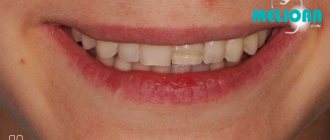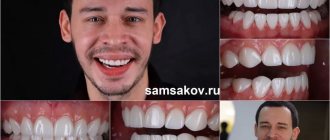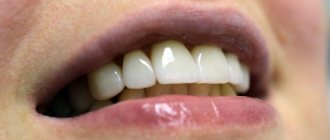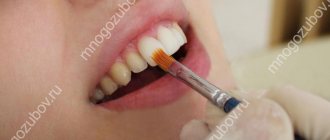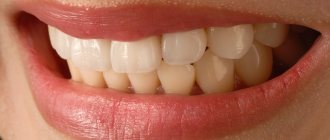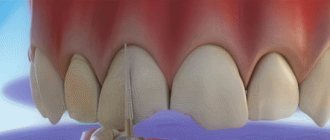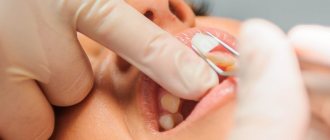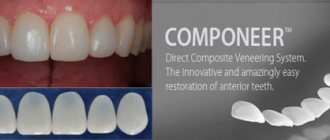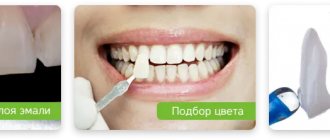Ceramic veneers are microprostheses for restoring the shape of a tooth and changing its color. They provide a long-lasting aesthetic effect that no other whitening method can provide. Due to their unlimited shelf life and high strength, they outperform composite materials used for dental restoration. At the same time, they are installed without traumatic treatment of the teeth, which cannot be avoided when using prosthetics with crowns.
Types of ceramic veneers
Based on the materials used for manufacturing, they are distinguished:
- Porcelain veneers made of pressed and unpressed ceramics. They have excellent aesthetics, adhere well to the teeth, but are not resistant to particularly heavy loads.
- Zirconium dioxide overlays. They consist of a zirconium frame on which a ceramic mass is applied. The material is extremely strong (stronger than metal), but has low adhesive properties (i.e., they are not securely fixed to the teeth).
Based on the thickness, microprostheses are divided into:
- ordinary (their thickness is 1.3-1.5 mm);
- ultranir (from 0.3 to 0.5 mm).
The best manufacturers
Microprostheses made from ceramics from the following manufacturers are widely used in aesthetic dentistry:
- E-max (German lithium silicate glass ceramics of increased strength);
- Empress (very thin and durable reinforced leucide glass ceramic, produced in Liechtenschnein);
- Finesse All Ceramic (American reinforced leucide glass ceramics);
- Cergo (German-made ceramics with a very smooth surface).
Vita scale
Not every patient is ready to ignore defects in the smile area, especially if you have to work with people when appearance is a calling card with a defining meaning.
Correction of a congenital or acquired aesthetic defect can be carried out using color restoration of teeth with veneers.
The Vita scale is a table of shades of elements of the dentition, divided into 4 classes , which are assigned the following letter indicators:
- A. Red-brown colors.
- B. Red-yellow.
- C. Shades of gray.
- D. Red-gray.
All classes are characterized by a degree of brightness, thereby optimally distributing shades on the scale. Number 1 corresponds to the maximum saturation and intensity of color, and number 4 indicates the lowest degree of brightness.
The additional distribution of colors allows the specialist to select aesthetic plates according to two parameters:
- class A, B, C or D;
- color for each veneer, identified by a double symbol, e.g. B
The entire palette consists of 16 different shades, making it possible to carry out competent prosthetics using comparative and corrective visualization.
First of all, the dentist determines the natural color of the patient’s teeth, and then, bringing the shades of the presented range one by one to the enamel, selects the most suitable option.
It is important to note! The Vita scale is made of laminated thick paper and plastic. The best model is a table with ceramic imprints or retractable acrylic plates.
In most cases, patients turn to dentists for help with the desire to install aesthetic adjustments of the lightest class. But after comparing the similarity of the sample with the existing shade of enamel, it becomes clear that the bright white color is burdened with a faint bluish tone, which creates unnaturalness and garishness.
"Hollywood" porcelain veneers
Special mention should be made of the so-called “Hollywood” veneers or lumineers (from the English luminary - luminary). These microprostheses have been decorating the smiles of American celebrities for 20 years now. Lumineers were once preferred by George Clooney, Tom Cruise, Angelina Jolie, Gwyneth Paltrow and other stars.
Lumineers are made from the strongest ceramics and are only 0.2-0.3 mm thick. The method of their production is patented and kept secret. These are the only microprosthetic onlays that are fixed to unground teeth.
Contraindications
Despite the versatility and practicality of the technique, there are limitations to the installation of veneers. For example, the use of plates is contraindicated in cases of bruxism, the presence of inflammatory processes, bone tissue pathology, and malocclusion.
Also, ceramic veneers are not used for the restoration of severely damaged teeth (more than 50%). In this case, the doctor installs crowns.
A refusal to carry out the procedure may be the presence of bad habits (biting nuts, nails, opening bottles with teeth, etc.). Or a high risk of maxillofacial injury. For example, extreme sports.
Gum disease and loss of chewing teeth will also require preliminary treatment before installing plates.
Manufacturing and installation
The entire process of prosthetic veneers takes about a week and involves two visits to the dentist.
How are veneers made?
Porcelain veneers can be made in two ways:
- layer-by-layer application and firing of porcelain mass (when working with unpressed ceramics);
- injection molding under the influence of high temperatures and pressure (this is how linings are made from pressed ceramics, which are considered more durable than those made from unpressed ceramics).
Microprostheses made of zirconium dioxide are manufactured using CAD/CAM technology:
- The CAD system creates a three-dimensional model of the overlay using a computer;
- The CAM system allows you to produce microprostheses according to a three-dimensional model on a highly accurate automatic milling machine (without human intervention).
The fastest way to automatically create a veneer from zirconium dioxide is to use the Cerec device (a set of technologies, equipment and materials for the production of ceramic microprostheses).
How are porcelain veneers installed?
Installation includes the following steps:
- Choice of color and type of overlay.
- Odontopreparation (removal of hard tooth tissues). To install conventional veneers and ultra-veneers, it is necessary to grind away from the tooth surface from half to one and a half millimeters. Lumineers are installed without grinding.
- Making an impression of the prepared tooth.
- Fixing a temporary plastic onlay (the ground tooth needs protection from the aggressive environment of the oral cavity while the onlay is being manufactured).
- Laboratory production of veneers based on impressions taken.
- Fastening the microprosthesis.
When installing lumineers, the second and fourth stages are omitted.
For what reasons can the shade of teeth change?
A naturally perfect snow-white smile is quite rare. In addition to the fact that most people’s teeth have a slight yellowish tint from birth, throughout their lives they are constantly exposed to external factors that cause their color to change. Here are just the main prerequisites:
- improper and irregular cleaning,
- addiction to coffee, strong tea and other coloring drinks,
- smoking cigarettes,
- aging of the body,
- dental diseases,
- consumption of products with intense coloring pigments,
- lack of vitamins and microelements or their excess in the body,
- taking certain medications.
To maintain the natural whiteness of your smile, you need to follow the rules of oral hygiene, respond in a timely manner to any suspicious changes, and regularly visit the dentist’s office for preventive examinations.
Reasons for changes in enamel color in children
- Some diseases of a pregnant woman: viral or bacterial infections of the mother’s body, as well as some medications (for example, tetracycline antibiotics) leave an imprint on the development of the fetus, including the formation of its tooth buds. This is fraught with the fact that the baby will erupt in units already with a defect (enamel hypoplasia or hyperplasia, tetracycline teeth, etc.),
- initial stage of caries: may change the color of milk crowns (white spots appear on them),
- fluorosis: a surplus of fluoride in a child’s body (due to the large consumption of fluoride-containing products, water, the use of toothpaste with a high content of this element) changes the color of the enamel, it becomes grayer and at the same time rough, brittle, with grooves,
- treatment with iron preparations: if they are used in liquid form, they cause temporary darkening of the tooth surface,
- constant consumption of coloring products: blueberries, bird cherry, sweets and drinks with artificial colors or based on red and blue berries.
Reasons for changes in tooth shade in adults
- violation of the rules of brushing teeth at home: irregularity, unsuitable toothpaste or brush,
- hereditary reasons
- the richness of the daily menu with pigmented products: black berries, strong black and red tea, coffee without milk, red wine, ketchup, soy sauce, etc.,
- smoking: gives a yellow or even gray-yellow coating,
- With age, dentin darkens and enamel becomes thinner: therefore, crowns acquire a darker shade than in youth - due to translucent dentin. Thinning of the enamel due to metabolic disorders also leads to a change in the color of the unit, because dentin is naturally yellow,
- deficiency or surplus of certain vitamins or microelements: zinc, fluorine, iron in the body,
- the presence of an old filling: often its elements penetrate into the dentin over time, oxidize and color it gray or red, which affects the external shade,
- microrelief of the crown surface: the more pronounced it is (grooves, pits, roughness), the darker the crowns appear.
Attention! After professional teeth cleaning (without bleaching), crowns may become a shade or even two lighter. This happens because the hygienist removes plaque, which gives a darker color, grinds and polishes the teeth, leveling the microrelief.
Care
Ceramic veneers require the same care as natural teeth. To preserve their aesthetics and extend their service life, it is recommended:
- reduce the consumption of foods with dyes (the linings will not change color, but the fixing cement may);
- wear a plastic mouthguard for bruxism - pathological grinding of teeth;
- do not subject teeth with veneers to increased stress (do not bite ice, do not open bottles, do not bite nails and hair ends, do not shell seeds);
- Do not miss dental checkups (once every six months).
The most popular colors
Bright shades are the most popular. Most often, patients choose shades a1, a2 and b1. These teeth look natural, but at the same time immediately attract attention with their color. Bleach is the choice of popular people. In the spotlight, on the TV screen, bright white teeth look attractive. It’s not for nothing that these colors are called “Hollywood white.” In real life, such shades hurt the eyes a little.
Advantages and disadvantages
Advantages:
- high aesthetic effect (ceramics differs from composites in that it retains its original color and, with high-quality processing, is no different from a real tooth);
- biocompatibility (ceramic veneers are hypoallergenic);
- durability (compared to composite onlays, the short-term whitening effect and the five-year service life of a conventional filling);
- minimal or zero treatment of the tooth (the tooth is ground much more strongly for a crown).
Flaws:
- high cost (restoration with composite materials is cheaper);
- instability to heavy loads (can peel off and break);
- irreversibility of the preparation (the tooth ground under the veneer will no longer be able to function normally after the onlay is removed).
Difficulty of choice
The choice of color depends on the number of restorations. For single teeth, it is important to choose a shade so that the restored tooth does not stand out. If the plates cover the entire visible dentition, then everything depends on the wishes of the patient. However, the dentist should explain the main approach to how to choose the color of veneers:
- Skin, hair and eye color
must be taken into account . The lighter the skin and hair, the less the teeth, even radically white ones, will stand out. - Eyes and teeth
are the first things people pay attention to. Dentists recommend choosing shades that match the whites of your eyes. - The size of the veneers
plays a role. Ultra-white colors visually enlarge the veneers, so for large teeth it is better to choose natural-colored veneers.
Reviews
Modern advances and the emergence of new materials in dentistry have helped thousands of patients fulfill their dream - to get a beautiful smile, and therefore get rid of embarrassment when communicating with others.
Several solutions have been found to restore your teeth to their attractiveness. The most popular method today is veneering. But in order for the veneers to be in harmony with your own teeth and not distort the general opinion about your appearance, it is important to choose the right color.
You can talk about your experience of restoring teeth using veneers, as well as share your opinion on the effectiveness of the process, by leaving a comment on this article.
If you find an error, please select a piece of text and press Ctrl+Enter.
Tags veneers fixed dentures
Did you like the article? stay tuned
No comments yet
Price issue
The cost of ceramic veneers is influenced by the material, installation method, and complexity of the procedure. As well as the qualifications of the doctor and the reputation of the clinic. On average, prices for pressed ceramics start at 23 thousand rubles. Zirconium ones will cost 35 thousand and more, composite ones - from 10 thousand rubles.
If after diagnosis the patient needs dental treatment, the final cost will be higher.
At EspaDent clinics, the patient learns the final amount immediately after the initial diagnosis. No surcharges or hidden fees. For expensive procedures, our patients have the option of interest-free installments. Diagnostics and initial examination in all EspaDent clinics are free of charge.
Useful tips
To prevent the patient from being disappointed with the transformation of his smile, experts recommend following a few simple rules and taking into account some points before coming to the clinic:
- Wear clothes in neutral (light) colors for the appointment , take them off for the duration of the appointment, or it is better not to complement the clothes with bright accessories.
- On the appointed day of your appointment, do not apply bright decorative cosmetics to your face , but wipe off lipstick and blush before entering the office.
- It is not recommended to lighten the enamel on the eve of the procedure.
- When choosing one or another color of veneers, it is important to take into account the color of your skin, your own teeth and hair color.
So, in people with naturally dark skin, the whites and teeth always look whiter. Therefore, overhead plates in lighter colors will suit them.For patients with a non-contrasting appearance, for example, Slavs, it is better to have veneers in natural shades, since snow-white microprostheses will look “screaming.”
- Come to the clinic in a good mood , tune in to positive communication with the dentist, and clearly state to him your wishes regarding the color of the veneers.
You need to understand that frequent changes of onlays are accompanied by an additional impact on the enamel coating, which negatively affects the health of the teeth. Therefore, the choice of shade of dental plates should be approached carefully.
In the video, the patient explains the principle by which she chose the color of the veneers.
